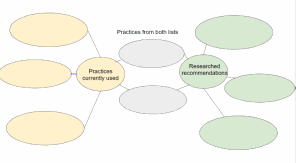Activity Directions: Explore Effective Instructional Practices
For more information about how to use this activity to support Exploring Instructional Practices, see the Action Overview: Exploration of EBPs.
Objective Develop shared understanding of criteria for determining if a practice is effective.
Time
Part I: Approximately 60 minutes
Part II: Approximately 60 minutes
Materials
Part I: Chart paper, markers, “My 5 Most Effective instructional practices” handout ,
Part II: Effective Teaching Practices Handout, Double Bubble Map background info. for the facilitator,
Part I: What criteria do we use to decide if an instructional practice is effective?
Directions
1. Write the following prompt on a large sheet of chart paper for each group: Describe your top 5 most effective instructional practices and why each one is effective.

2. Invite participants to think about the prompt and record their ideas. An example is provided above. Encourage participants to collaborate to come up with the 5 practices and why each practice is effective.
3. Once groups have listed their practices, provide time for participants to circulate to the other groups, reading the responses of each group. Encourage them to write comments or questions. Time permitting groups could then walk around to all other groups.
4. Participants return to their original group and address the following prompt:
· Identify specific information or data that are collected that indicates that these practices are effective.
5. Provide participants access to (or printed copies of) the summary of shared understanding of how students learn (from Activity 3). Each group identifies how their 5 practices align with the shared understanding of how students learn.
6. As full group reflection, participants discuss and record their thinking on the chart provided.
· What themes did you notice emerging?
· What questions do you have?
· What should the criteria be for determining if a practice is effective?
Part II: What does the research say is effective?
Directions
1. Provide copies or access to information about effective instructional practices for XXX content area. Each area has recommended practices. Examples may be found here…[hyperlink]
2. Provide time for participants to read through the document(s)
3. On the back side of the effective practices that were listed in Part I, invite participants, individually or collaboratively, to come up with the 5 practices that are recommended in the resources provided, and why each practice is effective.
4. As a full group, using a Double Bubble Map, list the practices from Part I in the outside bubbles connected to “Practices currently used”, and the lists from Part II in the outside bubbles connected to “Researched recommendations”. Those practices that are on both lists go into the bubbles in the middle.

This visual is just an example. More bubbles should be added as the need arises.
5. As full group reflection, participants discuss and record their thinking to the following questions:
· What do you notice?
· Why are these similarities and differences important?
· What have you learned from constructing this map?
6. In preparation for selecting effective practices to implement (the following activity), have the whole group discuss and record answers to the following:
a. What are our instructional strengths?
b. What are some instructional practices we use, but could improve?What are some instructional practices that we don't currently utilize well, that we could implement?






